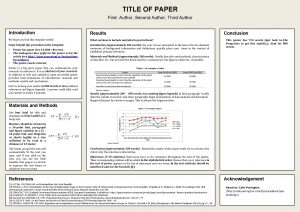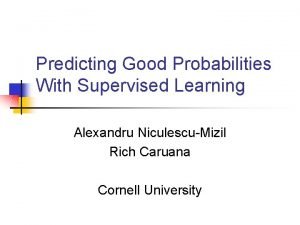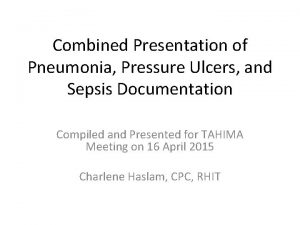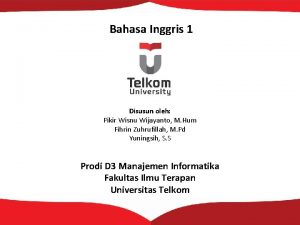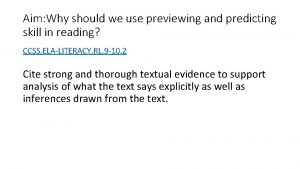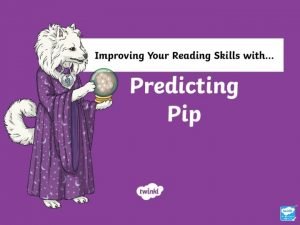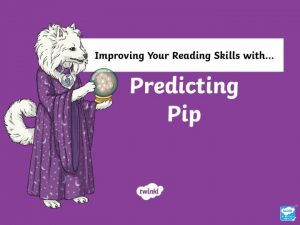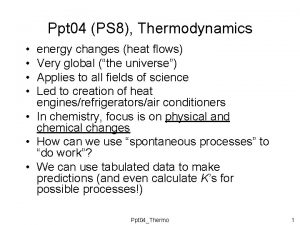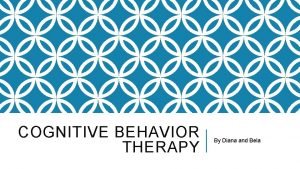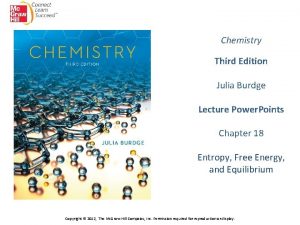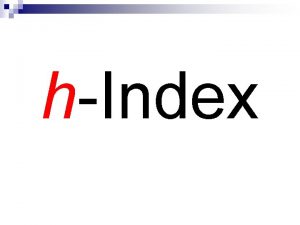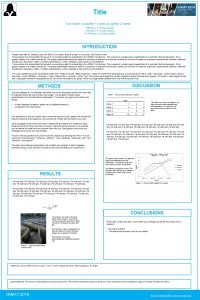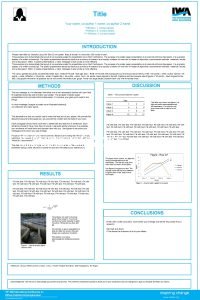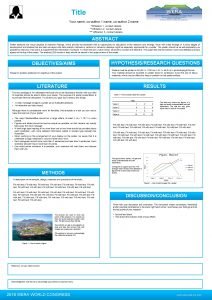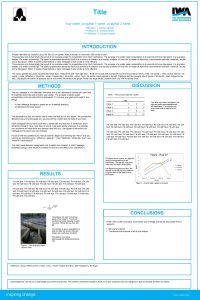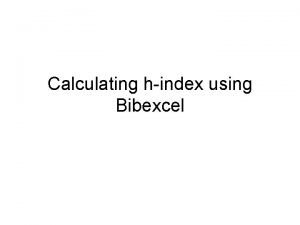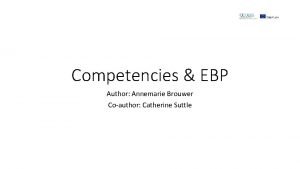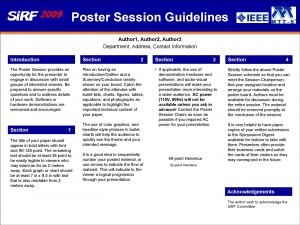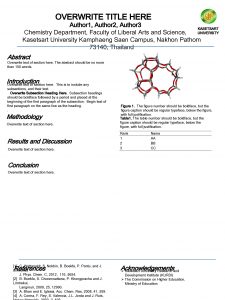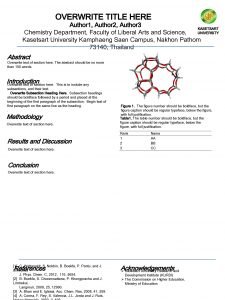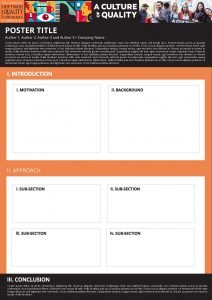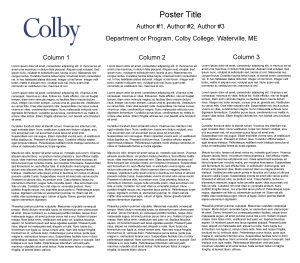Predicting author hindex using characteristics of the coauthor






















- Slides: 22

Predicting author h-index using characteristics of the co-author network Christopher Mc. Carty James Jawitz Allison Hopkins Alex Goldman University of Florida Supported by NSF grant SBE-0738116

Background • There is variability in the way people choose collaborators • We investigated how these behaviors affect scientific impact • We will discuss how Vivo could be used to maximize these behaviors

Collaboration Behaviors • Number of co-authors – Alone versus many collaborations – Teams of various size • Structure of collaborations – Dyadic interactions versus working in groups – One cohesive group versus many different groups – Disconnected groups versus groups with brokering • Characteristics of co-authors – Working with academics versus non-academics – Working with highly cited authors (Godfather/Godmother)

Research Question: How does the choice of collaborators in the co-author (egocentric) network affect this author’s scientific impact? • Many co-authors • Large teams • One highly cited co-author • At least two subgroups • Co-authors working in nonacademic settings

Research Design 1. Select a sample of authors from the ISI Web of Science 2. Calculate scientific impact for authors in sample 3. Create co-author network for sample 4. Build a model where: – The dependent variable is scientific impact – The independent variables reflect behaviors by an author in selecting co-authors

Scientific Impact – The h-index • A scientist has index h if h of his or her papers have at least h citations each (Hirsch 2005: 1) • Hirsch has an h-index of 52 – He published 52 papers that had been cited at least 52 times (as of September 20, 2009) – He published 161 papers not included in his hindex because none of them had been cited more than 52 times

Why use the h-index? Advantages • Minimizes bias due to: – Many publications that are not cited – A few publications with many citations • Provides an objective basis for evaluation • Easily calculated from the ISI Web of Science Citation Report Disadvantages • Only includes indexed journal articles (no books or book chapters) • Self-citation can inflate the index • Authors get equal credit regardless of contribution • Comparison across disciplines is controversial (although that is what we are doing)

Alternative metrics • • • m-quotient h-sequences h-rate Contemporary h-index Trend h-index AR-index Weighted h-index Tapered h-index Z-index • These all represent attempts to “fix” or “adjust” the h-index • These are all still objective measures relying on citations as the main product of a scientist

Why should we care about metrics? (Alison Abbott , David Cyranoski, Nicola Jones, Brendan Maher, Quirin Schiermeier & Richard Van Noorden (2010) “Metrics: Do Metrics Matter? ” Nature 465, 860 -862)

Sample selection • Downloaded all 760, 335 articles from ISI Web of Science for 2006 • Parsed the articles into authors (3, 441, 571 million records) • Unduplicated the list by combining author name and affiliation (3, 004, 948 records) • Randomly selected 594 authors • Calculated h-index for each author (this involved disambiguation)

Distribution of the h-index across the Web of Science (n=594) 60 50 40 Percent 30 20 10 0 0 3 6 9 12 15 18 21 24 27 30 33 36 39 42 45 48 51 54 57 60 63 66 69 72 75 78 81 84 H-Index

Procedure to Create Network • Randomly selected 250 authors from the list of 594 • Identified all authors in articles included in the h-index – Eleven authors had an h of zero resulting in no network – Four authors had co-author networks greater than 350 (one had over 4, 000). For these we randomly selected 50. • Calculated all of the edges between co-authors • Imported data into Ucinet for processing – Data are symmetric – For graph-based measures data were dichotomized at ties > 0

Variable Transformation: Respondent h-index (Ego. H) Ego. H Log. Ego. H

Variable Name Netsize Avg. Authors Components Isolates Betweenness Hierarchy Mean. Tie Academic Mean. Alterh Max. Alterh Hof. Most. EVC Description Behavior – Publish with… Number of Co-authors Number of authors across all Many different authors h-index articles Average authors per article Large teams Structure of collaborations Number of components with Disconnected groups ego removed Number of isolates with ego Disconnected co-authors removed Normalized mean Different connected groups betweenness Extent to which co-authors A highly connected brokering are brokered by single coco-author Average number of articles Co-authors who publish a lot published between co-authors Characteristics of Co-authors Proportion co-authors in Academics academic setting Average h-index of co-authors High h-index authors Highest h-index among coauthors H-index of most eigenvector central alter One high h-index author Transformation Logarithmic (Var+1) None Removed outlier with 37 isolates Logarithmic None Logarithmic One high h-index author who Logarithmic is highly connected

Isolates outlier • John Gill, MD • Research Scientist, Associate Professor of Medicine, Division of Nephrology, University of British Columbia • Research in clinical outcomes of organ transplant patients • Publishes many articles with a single co-author

Correlation among Independent variables Action: Eliminate Maxalterh and Hof. Most. EVC from model

Bivariate and Multivariate Models

Which collaborative behaviors matter?

Network size matters • The single most important behavior to increase the h-index is to publish with a lot of different people (Netsize) • This is likely due to the tendency for authors to cite their own work • Consider two authors: – Author A publishes 30 articles as a single author – Author B publishes 15 articles with one or more co-authors – Author B is likely to have a higher h-index because she can leverage the self-citation from co-authors

Application of Network Size to Vivo • Vivo will provide a large pool of potential collaborators with similar interests • Scientists can find people with similar funding backgrounds and who have cited the same articles • Vivo will make it possible to find scientists who have published books and book chapters, as well as conference proceedings, not indexed in the Web of Science

Other variables • Hierarchy measures the extent to which a network is constrained by a single node – High hierarchy implies a Godfather/Godmother who tends to publish with many co-authors – Egocentric network visualization using Vivo could make it easy to find these brokering nodes • Mean tie strength (Meantie) is negatively associated with the h-index. – As mean tie strength increases the h-index decreases – This is probably due to the negative association with network size • Mean alter h-index (Meanalterh) is positively associated with ego’s h-index – Publishing with co-authors who have high impact increases the h-index – Vivo will make it possible to find highly cited co-authors in their discipline • There is little reward for co-authoring with disconnected groups (Components)

Thank You! ufchris@ufl. edu
 First author second author third author
First author second author third author Predicting nba games using neural networks
Predicting nba games using neural networks Predicting products of chemical reactions
Predicting products of chemical reactions Predicting products of chemical reactions
Predicting products of chemical reactions Predicting products synthesis
Predicting products synthesis Alexandru niculescu-mizil
Alexandru niculescu-mizil Combination reaction equation
Combination reaction equation Braden scale for predicting pressure sore risk
Braden scale for predicting pressure sore risk Bahasa inggris disusun
Bahasa inggris disusun Braden scale for predicting pressure sore risk
Braden scale for predicting pressure sore risk Apa itu previewing and predicting
Apa itu previewing and predicting Prediction pip
Prediction pip Predicting pip
Predicting pip Vsepr theory definition
Vsepr theory definition Single replacement products
Single replacement products Thermodynamics ppt
Thermodynamics ppt Predicting spontaneity
Predicting spontaneity Vertical arrow technique
Vertical arrow technique Predicting spontaneity
Predicting spontaneity Predicting science process skills
Predicting science process skills Predicting science process skills
Predicting science process skills Predicting products
Predicting products Potassium chloride precipitate
Potassium chloride precipitate
